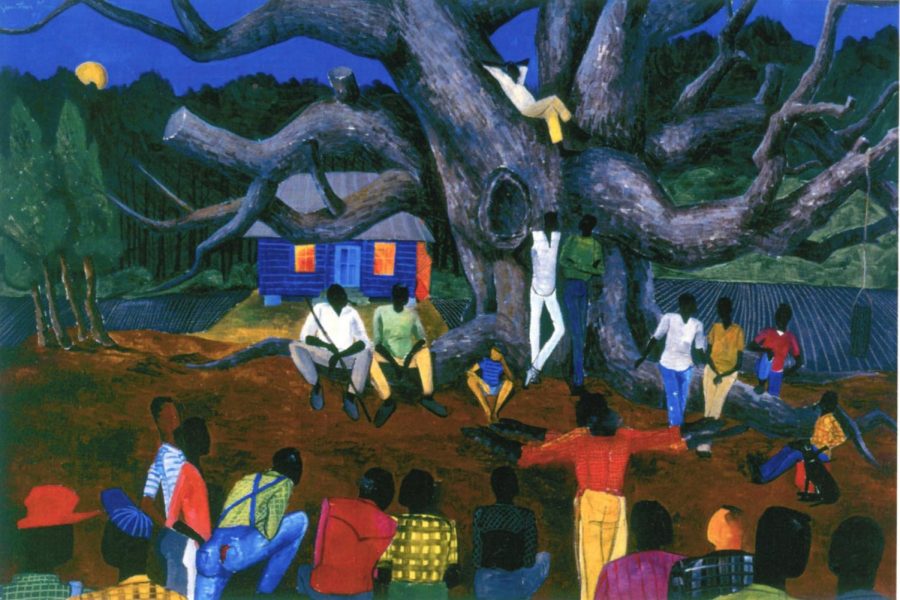Film series sheds light on origins of descendants
The Gullah people weave baskets for farm work, make casts for fishing and sew African textiles in quilts. African songs founded Gullah music. Their genre has inspired sounds in ragtime, blues, hip hop and jazz.
Feb 27, 2019
“Geechees and other Gullahs” was a film seminar hosted by professor J. Vern Cromartie not only for his sociology students but anyone willing to be educated as part of 2019 African American Heritage Month activities at Contra Costa College.
Before playing each film, Dr. Cromartie briefly told the audience about the history of the Gullah and Geechee people by way of PowerPoint slides.
The slides included definitions of key terms such as racial, ethnic, and social groups and made a distinction between Gullahs and Geechees.
During his breakdown, he defined the term Gullah as
referring to “black men, women and children who were born in Africa and brought to the U.S. in bondage and the language they brought with them.”
The Geechee, he said, are defined as “a social group of Gullah-speaking Maroons (and their descendants) who joined the Seminole Nation as partisans during their three wars with America in the 19th century.”
It was also revealed during the PowerPoint presentations that Cromartie himself is Gullah and can trace back his heritage as far back as six generations of his family.
The lecture hall in GE-225 was nearly full as Contra Costa College students attentively watched two films: “Black Warriors of the Seminole” and “De Florida a Couhulla,” which translates to “From Florida to Couhuila.”
The two films were meant to shed light on the rich history and culture of Geechee and Gullah people and how they have been upheld through the years.
“Black Warriors of the Seminole” tells the story of Gullah and Geechee that became part of the Seminole Nation, made up of several American Indian groups such as Creeks, Moskogees, Miccosukkees and Ogeechee.
These Gullah and Geechee people aided the Seminoles in their many wars against the United States throughout the 1800s.
The film points out that the heritage of the Seminoles is kept alive by grandparents telling stories to Seminole children and cooking cultural foods for them.
Contra Costa College Student Dylan Soungpanya said after the seminar that a film like this is important because it provides insight on a select group of people. He said, “Some may not care, but for those who want to get in touch with their culture the information is there for them.”
The second film included in the seminar was about the Mascogo, a group of black Seminoles who fled to Mexico and helped fight robbers on both sides of the border.
Much of the 50-minute film was in Spanish and gave a day-in-the-life perspective of Mascogos, including quotes from them on their customs and celebrations.
Discoveries by researchers were also included in the film, such as the realization that Gullah is spoken in Mexico, the Carolinas and Georgia.
Gullah is also strongly related to a language spoken by Creoles. Kyle Sandvand, a Diablo Valley College student visiting for the lecture, appreciated the seminar because he felt the films gave attention to a group that wouldn’t be noticed otherwise.
Cromartie said he chose to focus on Geechees and Gullahs specifically for the seminar because “Geechees and Gullahs have maintained more Africanisms than other groups of black people in the United States.”
Cromartie said that he’s known about his Geechee and Gullah heritage from the time he was a child and was inspired to do more research as he grew up.
The culmination of his research can be found in his published book entitled “Morgan-Frazier Family Clan” about the history of his lineage.
The book includes essays, interviews, documents and photographs that “chronicle the history of a Black family with a Geechee and Gullah heritage.”
The research in the book goes hand-in-hand with information he provided at the film seminar.



Dr C Sade Turnipseed • Mar 13, 2019 at 9:31 pm
This is such a wonderful project. Are the research and accompanying films available for use on other campuses?